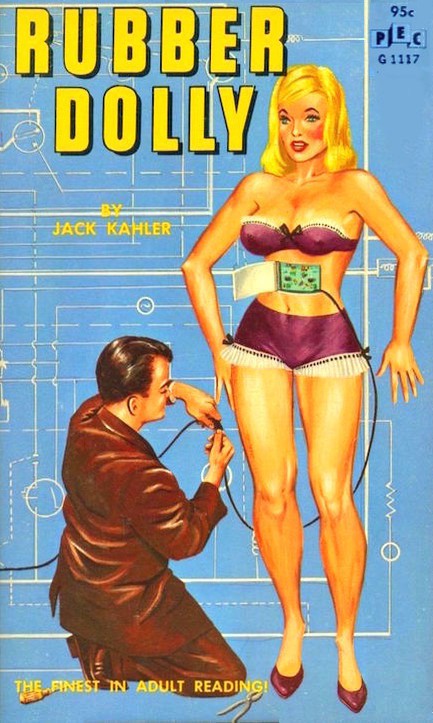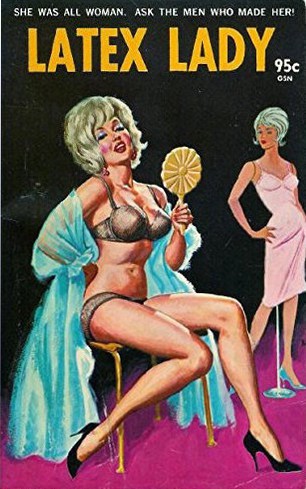| Vintage Pulp | Oct 27 2015 |

Totally lifelike. Just like a real woman. Limited warranty. Do not get wet—shock danger. Possible choking hazard. Vendor not liable for injuries resulting from friction burns.

 Above, the rather interesting cover for Jack Kahler’s Rubber Dolly, published by San Diego based PEC, aka Publishers Export Co., in 1966. So, what you get here is the owner of a Hollywood advertising agency called Premium Art who is surrounded by beautiful women 24/7 yet builds the most lifelike love doll ever made. Why? Well, he’s never satisfied. His name is Sam Bollen, after all. Hah hah. Ball-en. Anyway he builds his dolls—"so lifelike in action and substance they shocked even hardened business executives"—and everything is peachy at first, but he soon has problems of various bizarre sorts and even runs afoul of Hollywood communists. Amazing that Kahler could fit that in, but he was a genius—we’re talking about the same guy who came up with Passion Sauce (not be confused with The Lust Lotion). Though rubber doll sleaze may seem fringe, Rubber Dolly was actually a reissue of Kahler's successful Latex Lady from two years earlier. And of course this isn't the first mechanical love doll we've had on the site. The art is uncredited. Go figure.
Above, the rather interesting cover for Jack Kahler’s Rubber Dolly, published by San Diego based PEC, aka Publishers Export Co., in 1966. So, what you get here is the owner of a Hollywood advertising agency called Premium Art who is surrounded by beautiful women 24/7 yet builds the most lifelike love doll ever made. Why? Well, he’s never satisfied. His name is Sam Bollen, after all. Hah hah. Ball-en. Anyway he builds his dolls—"so lifelike in action and substance they shocked even hardened business executives"—and everything is peachy at first, but he soon has problems of various bizarre sorts and even runs afoul of Hollywood communists. Amazing that Kahler could fit that in, but he was a genius—we’re talking about the same guy who came up with Passion Sauce (not be confused with The Lust Lotion). Though rubber doll sleaze may seem fringe, Rubber Dolly was actually a reissue of Kahler's successful Latex Lady from two years earlier. And of course this isn't the first mechanical love doll we've had on the site. The art is uncredited. Go figure.



































































